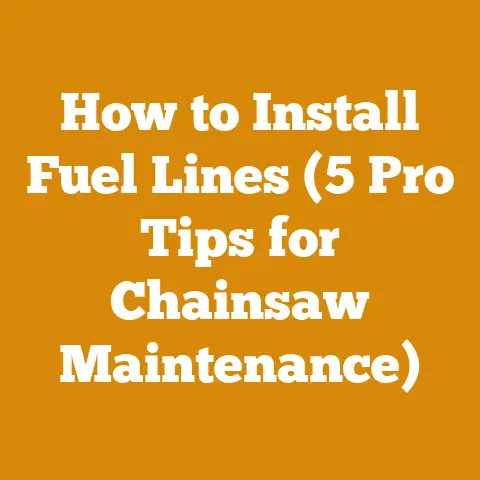DIY Outdoor Wood Furnace: Build Your Own Efficient Boiler (Expert Tips)
I can’t tell you how many times I’ve shivered through a winter night, staring at a thermostat that seems to mock my bank account. The cost of heating oil? Astronomical! The thought of being beholden to utility companies for warmth just felt…wrong. That’s when I started seriously considering an outdoor wood furnace. But not just any furnace. I wanted to build my own. The promise of energy independence, fueled by readily available (and potentially free) wood, was incredibly appealing. But the question that haunted me was: could I actually save money building my own efficient boiler, or would I end up with a costly pile of metal and a cold house? This article is my deep dive into that very question, a journey through the nuts and bolts (literally!) of designing, building, and budgeting for a DIY outdoor wood furnace.
DIY Outdoor Wood Furnace: Build Your Own Efficient Boiler (Expert Tips)
The allure of a DIY outdoor wood furnace is strong, promising freedom from ever-rising fuel costs and a satisfying sense of self-reliance. However, before you start welding and stocking up on steel, a thorough understanding of the costs involved is crucial. This isn’t just about saving money; it’s about making an informed decision and avoiding a financial pitfall. We will explore the financial implications of building your own efficient boiler, examining everything from material expenses and labor considerations to design choices and efficiency enhancements.
Understanding the Allure and the Reality: Why DIY?
Before diving into the cold, hard numbers, let’s address the “why.” Why would anyone choose to build their own outdoor wood furnace instead of simply buying a commercially available model?
- Cost Savings (Potentially): This is the big one. Commercially built outdoor wood furnaces can be expensive, ranging from a few thousand to tens of thousands of dollars. The hope is that DIY construction can significantly reduce this initial investment.
- Customization: Building your own allows you to tailor the furnace to your specific heating needs and property layout. You can optimize it for the types of wood available in your area and the size of your home.
- Self-Reliance and Skill Development: There’s a deep satisfaction in building something with your own hands, especially something as complex and essential as a heating system. It’s an opportunity to learn new skills in welding, metalworking, and plumbing.
- Control Over Materials and Construction: You get to choose the quality of materials and ensure that the furnace is built to your standards.
However, the DIY route isn’t without its challenges:
- Time Commitment: Building a furnace takes time – a lot of time. Be prepared to dedicate weekends, evenings, and possibly even vacation days to the project.
- Skill Requirements: Welding, plumbing, and metalworking skills are essential. If you don’t have these skills, you’ll need to learn them or hire someone who does.
- Safety Concerns: Working with fire, high temperatures, and potentially dangerous materials requires strict adherence to safety protocols.
- Permitting and Regulations: Local building codes and environmental regulations may apply to outdoor wood furnaces. You’ll need to research and comply with these regulations.
- Efficiency and Emissions: Achieving the same level of efficiency and emissions control as a commercially built furnace can be challenging. Poor design or construction can lead to wasted fuel and environmental concerns.
The Cost Breakdown: A Deep Dive into Expenses
Now, let’s get down to the nitty-gritty: the cost of building your own outdoor wood furnace. I’ve learned that every project is unique, but by breaking down the expenses into categories, we can create a realistic budget.
1. Materials: This is often the largest expense category.
- Steel: The primary material for the furnace body, firebox, and water jacket. The type and thickness of steel will significantly impact the cost.
- Mild Steel: A common and relatively inexpensive option, but it’s susceptible to rust and corrosion.
- Cost: $0.50 – $1.50 per pound, depending on thickness and supplier.
- Stainless Steel: More expensive but highly resistant to corrosion, extending the lifespan of the furnace.
- Cost: $2.00 – $5.00 per pound, depending on grade and supplier.
- Quantity Estimation: A medium-sized furnace might require 500-1000 pounds of steel.
- Personal Story: I initially considered using salvaged steel to save money. However, after factoring in the time and effort required to clean and prepare the steel, as well as the uncertainty about its quality, I decided to go with new steel. It was a worthwhile investment in the long run.
- Mild Steel: A common and relatively inexpensive option, but it’s susceptible to rust and corrosion.
- Insulation: Crucial for minimizing heat loss and maximizing efficiency.
- Mineral Wool: A popular choice due to its high temperature resistance and fireproof properties.
- Cost: $10 – $30 per square foot, depending on thickness and density.
- Ceramic Fiber Blanket: Another excellent insulator with even higher temperature resistance.
- Cost: $20 – $40 per square foot, depending on thickness and density.
- Quantity Estimation: You’ll need to insulate the entire furnace body, including the firebox and water jacket.
- Mineral Wool: A popular choice due to its high temperature resistance and fireproof properties.
- Plumbing Components: Pipes, fittings, valves, and pumps for circulating the heated water.
- PEX Tubing: A flexible and durable option for underground water lines.
- Cost: $0.50 – $1.50 per foot, depending on diameter and supplier.
- Circulator Pump: Essential for moving the heated water from the furnace to your home.
- Cost: $100 – $500, depending on flow rate and energy efficiency.
- Expansion Tank: Accommodates the expansion of water as it heats up.
- Cost: $50 – $150, depending on size.
- Fittings and Valves: Various fittings and valves will be needed to connect the plumbing components.
- Cost: $50 – $200, depending on the complexity of the system.
- PEX Tubing: A flexible and durable option for underground water lines.
- Firebox Components: Firebrick, grate, and door for containing the fire.
- Firebrick: Protects the steel firebox from the intense heat of the fire.
- Cost: $1 – $5 per brick, depending on size and type.
- Grate: Supports the wood and allows for airflow.
- Cost: $50 – $200, depending on size and material.
- Firebox Door: Provides access to the firebox for loading wood and cleaning ash.
- Cost: $100 – $500, depending on size and features.
- Firebrick: Protects the steel firebox from the intense heat of the fire.
- Controls and Safety Devices: Thermostat, pressure relief valve, and other safety devices.
- Thermostat: Regulates the water temperature and controls the circulator pump.
- Cost: $50 – $150.
- Pressure Relief Valve: Prevents over-pressurization of the system.
- Cost: $20 – $50.
- Aquastat: Senses the water temperature and controls the combustion air.
- Cost: $30 – $100.
- Thermostat: Regulates the water temperature and controls the circulator pump.
- Other Materials: Welding rods, paint, sealant, and other miscellaneous supplies.
- Cost: $50 – $200.
Data Points and Statistics:
- Steel Prices: According to the World Steel Association, global steel prices fluctuate based on supply and demand, economic conditions, and raw material costs. Keep an eye on these trends to anticipate price changes.
- Insulation Market: The insulation market is projected to grow significantly in the coming years, driven by increasing energy efficiency standards. This may lead to higher prices for insulation materials.
2. Labor: If you’re not doing all the work yourself, labor costs can add up quickly.
- Welding: If you’re not a skilled welder, you’ll need to hire someone to weld the steel components.
- Cost: $50 – $100 per hour, depending on experience and location.
- Time Estimate: Welding the entire furnace could take 20-40 hours.
- Plumbing: Installing the plumbing system requires specialized skills.
- Cost: $50 – $100 per hour, depending on experience and location.
- Time Estimate: Plumbing the system could take 10-20 hours.
- Electrical: Connecting the electrical components requires a qualified electrician.
- Cost: $50 – $100 per hour, depending on experience and location.
- Time Estimate: Electrical work could take 2-4 hours.
Personal Story: I decided to take a welding course at my local community college. Not only did it save me money on labor costs, but it also gave me a sense of accomplishment and a valuable new skill.
3. Tools and Equipment: You’ll need a variety of tools and equipment to build your furnace.
- Welder: A welding machine is essential for joining the steel components.
- Cost: $200 – $2000, depending on type and features. You can also rent a welder for around $50-$100 per day.
- Cutting Torch: For cutting steel plates and pipes.
- Cost: $100 – $500.
- Grinder: For smoothing welds and preparing surfaces.
- Cost: $50 – $200.
- Drill: For drilling holes for bolts and fittings.
- Cost: $50 – $200.
- Plumbing Tools: Pipe wrench, pipe cutter, and other plumbing tools.
- Cost: $50 – $200.
- Safety Equipment: Welding helmet, gloves, safety glasses, and ear protection.
- Cost: $50 – $200.
4. Permits and Inspections: Local building codes may require permits and inspections for outdoor wood furnaces.
- Permit Fees: $50 – $500, depending on location and the complexity of the project.
- Inspection Fees: $50 – $200 per inspection.
5. Design and Engineering: Creating a safe and efficient furnace design requires careful planning and engineering.
- Design Plans: You can find free or paid design plans online, or you can hire a professional engineer to create custom plans.
- Cost: $0 – $500 for pre-made plans, or $500 – $2000 for custom plans.
- Engineering Consultation: Consulting with an engineer can help you optimize the design and ensure that it meets safety standards.
- Cost: $50 – $100 per hour.
6. Contingency Fund: It’s always a good idea to set aside a contingency fund for unexpected expenses.
- Recommended: 10-20% of the total estimated cost.
Example Cost Breakdown (Medium-Sized Furnace):
| Category | Estimated Cost | Notes |
|---|---|---|
| Materials | $2,000 – $5,000 | Steel (500-1000 lbs), insulation, plumbing components, firebox components, controls, and other materials. |
| Labor (Welding) | $1,000 – $4,000 | Assuming 20-40 hours of welding at $50-$100 per hour. |
| Tools and Equipment | $500 – $2,000 | Welder, cutting torch, grinder, drill, plumbing tools, and safety equipment. This could be lower if you already own some of the tools or choose to rent them. |
| Permits and Inspections | $100 – $700 | Varies depending on location. |
| Design and Engineering | $0 – $2,000 | Depending on whether you use free plans, purchase pre-made plans, or hire a professional engineer. |
| Contingency Fund | $360 – $2,740 | 10-20% of the total estimated cost. |
| Total Estimated Cost | $3,960 – $16,440 | This is a wide range, but it reflects the variability in material choices, labor costs, and design complexity. |
Important Considerations:
- Wood Source: Do you have access to free or low-cost wood? If you have to buy wood, the cost savings of a wood furnace may be diminished.
- Time Value: How much is your time worth? Building a furnace is a time-consuming project. Consider the opportunity cost of spending your time on this project instead of other activities.
- Long-Term Maintenance: Wood furnaces require regular maintenance, including cleaning the firebox, inspecting the chimney, and replacing worn parts. Factor these costs into your long-term budget.
Optimizing Your Design for Efficiency and Cost Savings
The design of your outdoor wood furnace is crucial for both efficiency and cost savings. A well-designed furnace will burn less wood, require less maintenance, and last longer. Here are some key design considerations:
- Firebox Size: The firebox should be sized appropriately for your heating needs. A firebox that is too small will require frequent refueling, while a firebox that is too large will waste fuel.
- Water Jacket Design: The water jacket should be designed to maximize heat transfer from the firebox to the water. This can be achieved by using a large surface area and optimizing the flow of water around the firebox.
- Insulation: Proper insulation is essential for minimizing heat loss. Use high-quality insulation materials and ensure that all surfaces are adequately insulated.
- Combustion Air Control: Controlling the amount of air that enters the firebox is crucial for efficient combustion. A properly designed air control system will ensure that the wood burns cleanly and completely.
- Chimney Design: The chimney should be sized appropriately for the furnace and should provide adequate draft. A chimney that is too small will restrict airflow, while a chimney that is too large will allow heat to escape.
- Secondary Combustion: Incorporating a secondary combustion chamber can significantly improve efficiency and reduce emissions. Secondary combustion burns off the unburned gases and particles that are produced during primary combustion.
Data Points and Statistics:
- EPA Regulations: The Environmental Protection Agency (EPA) has established regulations for outdoor wood furnaces to reduce emissions. Ensure that your design meets these regulations.
- Efficiency Ratings: Look for furnaces with high efficiency ratings. The higher the efficiency rating, the less wood you’ll need to burn to heat your home.
Personal Story: I spent a lot of time researching different furnace designs and talking to experienced builders. I learned that the key to efficiency is maximizing heat transfer and minimizing heat loss. I incorporated several features into my design, including a large water jacket, high-quality insulation, and a secondary combustion chamber.
Wood Selection and Preparation: Fueling Your Investment
The type of wood you burn and how you prepare it can have a significant impact on the efficiency and cost-effectiveness of your outdoor wood furnace.
- Wood Species: Different wood species have different heat values. Hardwoods, such as oak, maple, and ash, have higher heat values than softwoods, such as pine and fir.
- Heat Value: Measured in BTUs (British Thermal Units) per cord.
- Example: Oak: 24 million BTUs per cord; Pine: 15 million BTUs per cord.
- Moisture Content: Burning wet wood is inefficient and produces more smoke. Wood should be seasoned (dried) for at least six months to reduce its moisture content.
- Ideal Moisture Content: 20% or less.
- Drying Time: Varies depending on the wood species, climate, and storage conditions.
- Wood Size: The size of the wood pieces should be appropriate for the firebox. Large pieces will burn slowly, while small pieces will burn quickly.
- Wood Source: Do you have access to free or low-cost wood? If you have to buy wood, the cost savings of a wood furnace may be diminished.
Data Points and Statistics:
- Firewood Prices: Firewood prices vary depending on location, wood species, and quantity purchased. According to the USDA Forest Service, the average price of firewood in the United States is $200-$400 per cord.
- Seasoning Time: The USDA Forest Service recommends seasoning firewood for at least six months to reduce its moisture content to 20% or less.
Personal Story: I learned the hard way that burning wet wood is a waste of time and money. It produces a lot of smoke, doesn’t generate much heat, and can even damage your furnace. Now, I always make sure to season my wood for at least a year before burning it.
Budgeting and Cost Management: Staying on Track
Building a DIY outdoor wood furnace can be a significant investment. It’s important to create a detailed budget and track your expenses carefully to stay on track.
- Create a Detailed Budget: List all the expenses you anticipate, including materials, labor, tools, permits, and design fees.
- Get Multiple Quotes: Shop around for the best prices on materials and labor.
- Prioritize Quality: Don’t skimp on quality materials or workmanship. A well-built furnace will last longer and be more efficient.
- Track Your Expenses: Keep track of all your expenses and compare them to your budget.
- Be Prepared for Unexpected Costs: Set aside a contingency fund for unexpected expenses.
- Consider Financing Options: If you don’t have the cash to pay for the project upfront, consider financing options such as a home equity loan or a personal loan.
Cost Optimization Tips:
- Salvage Materials: Look for opportunities to salvage materials, such as steel, plumbing components, and insulation.
- Do Some of the Work Yourself: If you have the skills, do some of the work yourself to save on labor costs.
- Buy in Bulk: Buy materials in bulk to get a discount.
- Negotiate Prices: Don’t be afraid to negotiate prices with suppliers and contractors.
- Shop Around for Tools: Compare prices on tools before you buy them. Consider renting tools instead of buying them if you only need them for a short period of time.
The Commercial Alternative: A Cost-Benefit Analysis
While the focus of this article is on DIY construction, it’s important to consider the alternative: purchasing a commercially built outdoor wood furnace.
Advantages of Commercial Furnaces:
- Efficiency and Emissions: Commercially built furnaces are typically more efficient and produce fewer emissions than DIY furnaces.
- Warranty: Commercial furnaces come with a warranty, which protects you against defects in materials and workmanship.
- Ease of Installation: Commercial furnaces are typically easier to install than DIY furnaces.
- Safety: Commercial furnaces are designed and tested to meet safety standards.
- Financing Options: Many manufacturers offer financing options for commercial furnaces.
Disadvantages of Commercial Furnaces:
- Cost: Commercial furnaces are typically more expensive than DIY furnaces.
- Limited Customization: You may not be able to customize a commercial furnace to your specific needs.
- Dependence on Manufacturer: You are dependent on the manufacturer for parts and service.
Cost-Benefit Analysis:
To determine whether it’s more cost-effective to build your own furnace or buy a commercial one, you need to consider the following factors:
- Your Skill Level: Do you have the skills and experience to build a safe and efficient furnace?
- Your Time Commitment: Are you willing to dedicate the time and effort required to build a furnace?
- Your Budget: How much money are you willing to spend on a furnace?
- Your Heating Needs: How much heat do you need to generate?
- Your Wood Source: Do you have access to free or low-cost wood?
- Long-Term Maintenance Costs: How much will it cost to maintain the furnace over its lifespan?
Example Scenario:
Let’s say you’re considering building a DIY furnace for $5,000 or buying a commercial furnace for $10,000. The commercial furnace is 20% more efficient, meaning you’ll burn 20% less wood each year. If you burn 10 cords of wood per year at a cost of $300 per cord, you’ll save $600 per year on fuel costs with the commercial furnace.
In this scenario, it would take about 8.3 years ($5,000 / $600) to recoup the difference in cost between the DIY furnace and the commercial furnace. However, you also need to consider the potential for lower maintenance costs with the commercial furnace and the value of your time spent building the DIY furnace.
Real-World Case Studies: DIY Successes and Failures
To provide further insight into the costs and benefits of building a DIY outdoor wood furnace, let’s examine a few real-world case studies:
Case Study 1: The Successful DIYer
- Name: John
- Location: Rural Maine
- Project: Built a medium-sized outdoor wood furnace to heat his home and workshop.
- Cost Breakdown:
- Materials: $3,000 (salvaged steel, purchased insulation and plumbing components)
- Labor: $0 (John did all the work himself)
- Tools: $500 (owned most of the tools, purchased a used welder)
- Permits: $100
- Design: $0 (used free online plans)
- Total Cost: $3,600
- Results: John estimates that he saves $2,000 per year on heating costs. His furnace has been running for five years with minimal maintenance.
- Key to Success: John had strong welding and plumbing skills, access to salvaged materials, and a clear understanding of his heating needs.
Case Study 2: The Costly Mistake
- Name: Sarah
- Location: Suburban Pennsylvania
- Project: Attempted to build a large outdoor wood furnace to heat her home and pool.
- Cost Breakdown:
- Materials: $6,000 (new steel, high-end insulation and plumbing components)
- Labor: $4,000 (hired a welder and plumber)
- Tools: $1,000 (purchased new tools)
- Permits: $500
- Design: $1,000 (hired an engineer)
- Total Cost: $12,500
- Results: Sarah’s furnace was poorly designed and inefficient. It burned a lot of wood and produced excessive smoke. She eventually abandoned the project and purchased a commercial furnace.
- Key to Failure: Sarah lacked the necessary skills and experience, underestimated the cost of the project, and failed to properly research the design.
Case Study 3: The Middle Ground
- Name: Tom
- Location: Rural Montana
- Project: Built a small outdoor wood furnace to heat his garage.
- Cost Breakdown:
- Materials: $1,500 (new steel, basic insulation and plumbing components)
- Labor: $500 (hired a welder for a few critical welds)
- Tools: $200 (rented tools)
- Permits: $0 (not required in his area)
- Design: $200 (purchased pre-made plans)
- Total Cost: $2,400
- Results: Tom’s furnace is functional and provides adequate heat for his garage. He estimates that he saves $500 per year on heating costs.
- Key to Success: Tom kept the project simple, used basic materials, and hired a welder for only the most critical welds.
These case studies illustrate that the success of a DIY outdoor wood furnace project depends on a variety of factors, including skill level, budget, design choices, and access to resources.
Actionable Takeaways and Next Steps
Building your own outdoor wood furnace can be a rewarding and cost-effective project, but it’s essential to approach it with a clear understanding of the costs involved and the challenges you’ll face. Here are some actionable takeaways and next steps:
- Assess Your Skills: Honestly evaluate your welding, plumbing, and metalworking skills. If you lack these skills, consider taking a course or hiring a professional.
- Research Local Regulations: Check with your local building department to determine if permits are required and what regulations apply to outdoor wood furnaces.
- Develop a Detailed Design: Choose a design that is appropriate for your heating needs and skill level. Consider using free online plans, purchasing pre-made plans, or hiring an engineer.
- Create a Realistic Budget: List all the expenses you anticipate and get multiple quotes for materials and labor.
- Gather Your Tools: Make sure you have all the necessary tools and equipment before you start the project. Consider renting tools instead of buying them if you only need them for a short period of time.
- Start Small: If you’re new to welding or metalworking, start with a small project to gain experience before tackling a full-sized furnace.
- Prioritize Safety: Always wear appropriate safety gear when working with fire, high temperatures, and potentially dangerous materials.
- Seek Expert Advice: Don’t be afraid to ask for help from experienced builders or engineers.
- Consider the Commercial Alternative: Compare the costs and benefits of building your own furnace versus buying a commercial one.
- Prepare for the Long Haul: Building a furnace is a time-consuming project. Be prepared to dedicate weekends, evenings, and possibly even vacation days to the project.
Building a DIY outdoor wood furnace is not a walk in the park, but with careful planning, realistic budgeting, and a healthy dose of elbow grease, you can achieve energy independence and save money on heating costs. It’s about weighing the upfront investment of time and resources against the potential long-term savings and the satisfaction of creating something with your own two hands. So, roll up your sleeves, gather your tools, and get ready to turn your woodpile into a source of warmth and pride.






